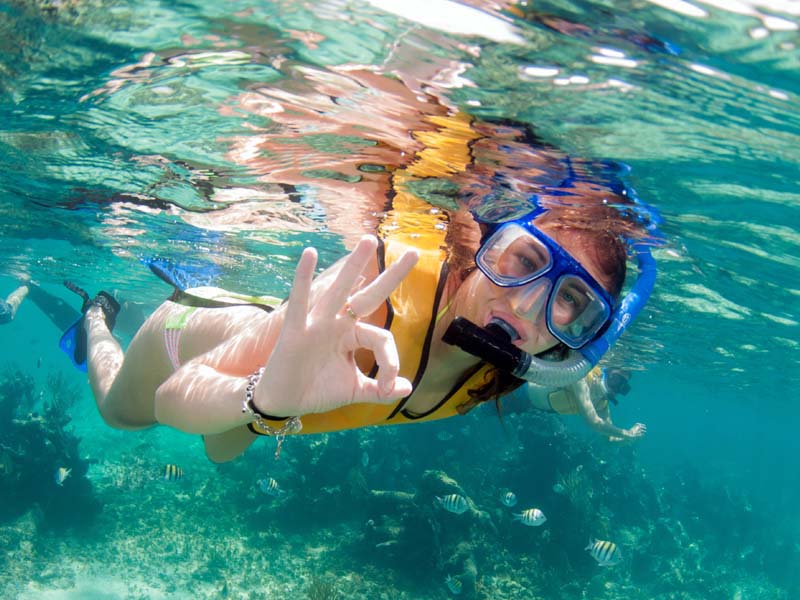



 Snorkeling is the quickest and easiest way to enjoy the warm Caribbean waters of the Mayan Riviera. If you can float, you can snorkel. Like any other activity, however, a little knowledge and a little practice will help you make the most of your experience.
Snorkeling is the quickest and easiest way to enjoy the warm Caribbean waters of the Mayan Riviera. If you can float, you can snorkel. Like any other activity, however, a little knowledge and a little practice will help you make the most of your experience.
There's nothing complicated about the equipment needed for snorkeling. You're probably familiar with the basics already.
If you're a real fan of snorkeling, you'll probably want to buy your own mask and snorkel. Masks are all about fit and comfort. You'll want to try on several before you buy, so find a well-stocked scuba diving shop. A good fit means a good seal. To test the fit, place the mask firmly on your face, covering your eyes and nose, and inhale deeply through your nose. (Make sure neither your hair nor the straps get in the way.) If the mask stays in place once you let go, you can be confident that the seal will hold up underwater. Masks are also available with built-in corrective lenses. (Since looking through the mask and water tends to magnify objects, many near-sighted snorkelers find they can do without corrective lenses.)
The comfort rule also applies to snorkels. In particular, the snorkel mouthpiece should feel soft and pliable in your mouth. You should definitely consider buying a semi-dry snorkel, as opposed to the cheaper models. The purge valves in semi-dry snorkels minimize the amount of water entering the breathing tube.
Selecting the right fins is a little trickier because you can't really be sure how they'll fit until you get them in the water. If your fins are too loose, you may end with a blister. If they're too tight, you won't be able to swim with full power. Unless you're a very strong swimmer, you should avoid large fins. They demand a lot of muscle power and can leave you tired. For most snorkelers, relatively small, open-toe fins are the best bet.
Now that you have the proper snorkeling gear, it's time to try it out in the water. You'll probably first want to slip into your fins. (Walking in your fins is not wise, and can be dangerous on an undulating boat, so don't put them on too early.) To keep your mask from fogging up inside, you'll want to apply a defogging substance on the inner surface of the mask just before you put it on. Although you can buy a mask defogger, nothing is more effective than your own saliva. Just smear it around, dip the mask into the water for a quick rinse, and then strap on your mask.
When using a snorkel, the trick is to keep the breathing tube upright as you are swimming face-down. You'll need to adjust the snorkel strap to find the right position. (Of course, for guests of Paradise Catamarans, our guides will be there to help you at every step of the way.)
Once you're gliding along the surface, make sure that you're comfortable with your equipment and your surroundings before you head below. There's a right way to dive and resurface too. To conserve your air supply, you'll want to descend as quickly as possible. For most people, the easiest method is to point their head down and their legs up out of the water. Gravity will take you down effortlessly. At some point, you'll need to begin kicking to propel yourself forward.
Likewise, let gravity work on your behalf when you resurface. Point your head up and kick to push yourself upward. Make sure you tilt your head back to watch where you're going. You wouldn't want to bump into another snorkeler or the bottom of your boat. When you reach the surface, your breathing tube should be pointing down so that the water drains out. If possible, exhale into the snorkel to force out any remaining water.
If you notice a little pressure on your ears after a dive, you may want to take a minute to relieve the pressure. Hold your nose and gently blow. You should hear a crackling sound as the pressure subsides. If you're suffering from a cold or sinus problems, you should probably avoid going more than a few feet below the surface.
Above all, make sure that you are relaxed and comfortable enough to enjoy your underwater adventure. Snorkeling is a water sport for just about everyone. Don't miss out on your share of the fun.